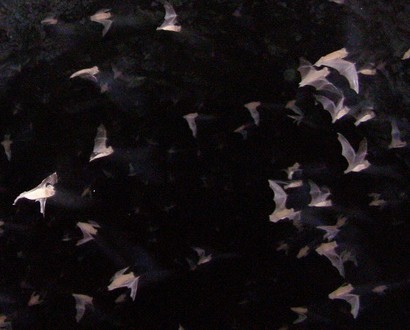|
Bats
are coming back to Texas for the summer,
which isn’t news because bats have spent their summers in Texas
for the past 10,000 years. Only their failure to return would rate
a banner headline.
As it is and has been, about 100 million bats, mostly Mexican free
tail bats, make their summer homes in Texas.
The bats love Texas for the same reason
a lot of people do: geography and climate. Bats love caves and the
state has some 3,000 caves and sinkholes though most of the bat colonies
are concentrated in about two dozen of those caves. Bracken Cave
near Frederiksburg
has a thriving metropolis of 20 million bats, the largest known bat
colony in the world. Those 20 million bats can eat 200 tons of insects
in a single night, including mosquitoes and agricultural pests that
plague cotton and corn
crops. |
 |
While taking
sensible precautions in regards to bats as carriers of rabies, we
have asked our bats to wipe out other diseases. We have even enlisted
bats in the war effort. Results of these experiments have been mixed.
Early
in the 20th Century, Dr. Charles Campbell, a
physician, built a “municipal bat roost” as part of an effort
to fight malaria, which killed millions of people worldwide each year.
Dr. Campbell saw the ravages of the disease in some his own patients
and wondered if bats could be colonized like bees in bat towers to
prosper and multiply and end the ravages of malaria once and for all.
Bats turned out to be pickier about where they lived than Dr. Campbell
first imagined; they stayed away from his first bat towers in droves.
Giving the matter closer observation he decided to try again, this
time closer to water. A bat tower he built in 1911 near swampy Mitchell’s
Lake a few miles south of San
Antonio proved the first glimmer of hope.
Mitchell's Lake was notorious for its hordes of mosquitoes and no
wonder: this was where San
Antonio’s sewage flowed, creating perfect breeding grounds for
mosquitoes. Tenant farmers in the area were so bedeviled by the swarms
of mosquitoes that they often were forced to leave their fields untended
and the livestock in sorry condition. Dr. Campbell later wrote that
of 87 people he examined near Mitchell’s Lake in 1911, 78 suffered
from malaria.
The bat tower at Mitchell’s Lake brought a few bats the first year,
more bats the next year and a veritable horde the following year.
Where it once took him five minutes to watch the bats spiral from
the tower each summer evening, it soon took two hours. People came
and watched the spectacle, much as the bat roost under the Congress
Avenue Bridge today attracts visitors every evening when the bats
are in town.
Within four years, farmers near Mitchell’s Lake reported that they
could now work their fields without being attacked by dense clouds
of blood-sucking mosquitoes. Malaria all but disappeared from the
area.
Dr. Campbell’s efforts brought him a Nobel Peace Prize nomination
in 1919 but the bat towers soon faded from public consciousness and
the landscape. There may be a handful of the original towers left
here and there but most have given way to the ravages of time and
progress.
In a 1989 article for the Bat Conservation International magazine,
editor Mari Murphy noted that the disappearance of malaria around
the time of Dr. Mitchell’s bat towers was well documented but the
extent to which the roosts could be credited was not scientifically
studied and thus open to question.
“The success of Dr.. Campbell’s experiments can no longer be tested,
since most of his bat roosts and the original mosquito breeding conditions
are now gone,’ she wrote. |
Bat Bombs
While Dr. Campbell’s
bat towers are viewed today as an idea that just might have worked
– we can’t say for sure – an idea hatched in top secrecy during World
War II leaves no room for such ambiguity.
Not long after the Japanese
bombing of Pearl Harbor, the U.S. Government put an oddball cast
of characters to work researching how bats might be turned into small
incendiary bombs and dropped on Japan. Really. The research was carried
out in unlikely places like Bandera,
Carlsbad, New Mexico, and California. It cost about $2 million and
involved a lot of risky behavior in caves, recruiting these unlikely
flying mammals into the war effort.
The plan concocted by the researchers involved refrigerating the bats
into hibernation then equipping them with tiny parcels of napalm and
little bitty parachutes and dropping them on Japanese cities, which
would burn to the ground when the bats flew into the nearest buildings.
That was the plan.
Details of the unlikely project, from batty conception to fiery conclusion,
is chronicled by the youngest member of the team, Jack Couffer, in
his book “Bat Bomb: World War II’s Other Secret Weapon” published
by the University of Texas Press in 1992.
As it turned out, the bats couldn’t be whisked into hibernation and
snapped out of it on any kind of convenient or reliable schedule.
The parachutes were too small. The napalm bombs were too big. When
the bat bombs were tossed from airplanes some of the bats hit the
ground without ever waking up while others ended up with broken wings.
A few lucky ones survived the free fall and flew off, just as expected,
into the nearest buildings, which turned out to be the airport hangars
at a brand new military airfield. The hangars burned to the ground,
a general’s automobile was incinerated, and that was that.
The military dropped the bat bomb project but proceeded with another
plan that showed promise, something called an atomic bomb.
© Clay Coppedge
"Letters from Central Texas"
May
5 , 2008 Column |
|
|
